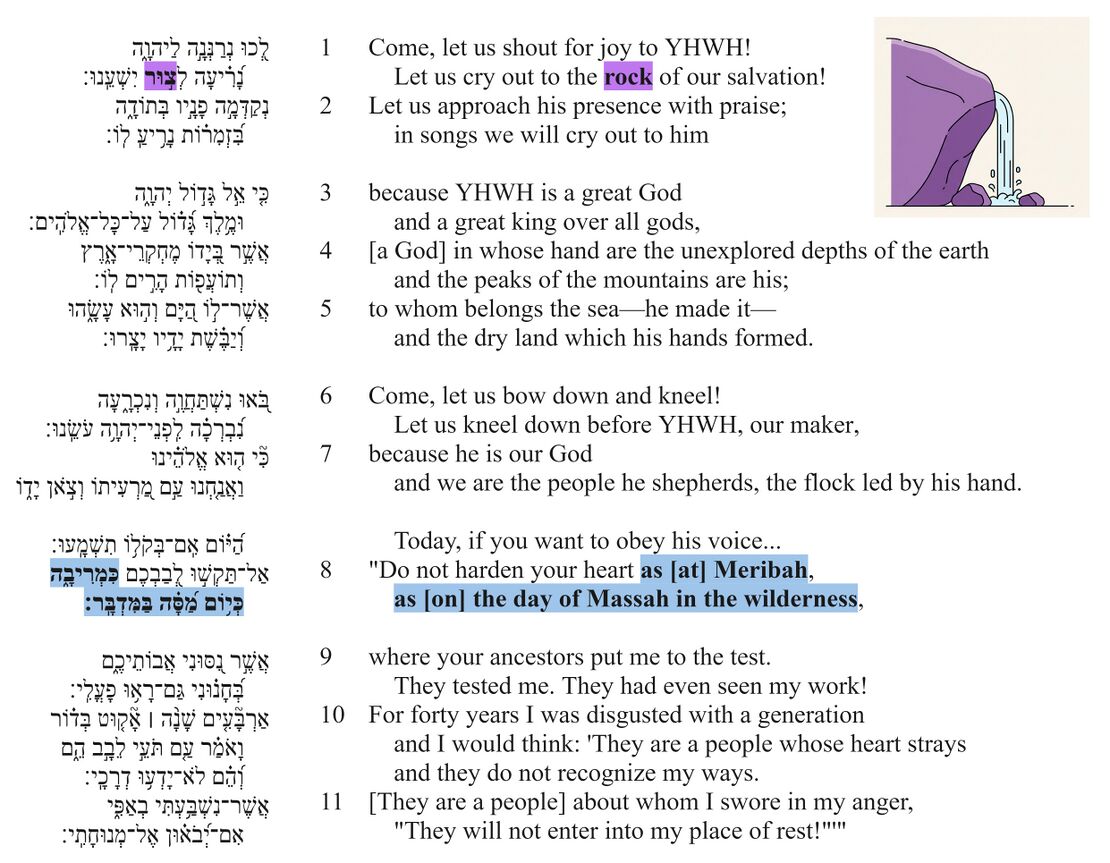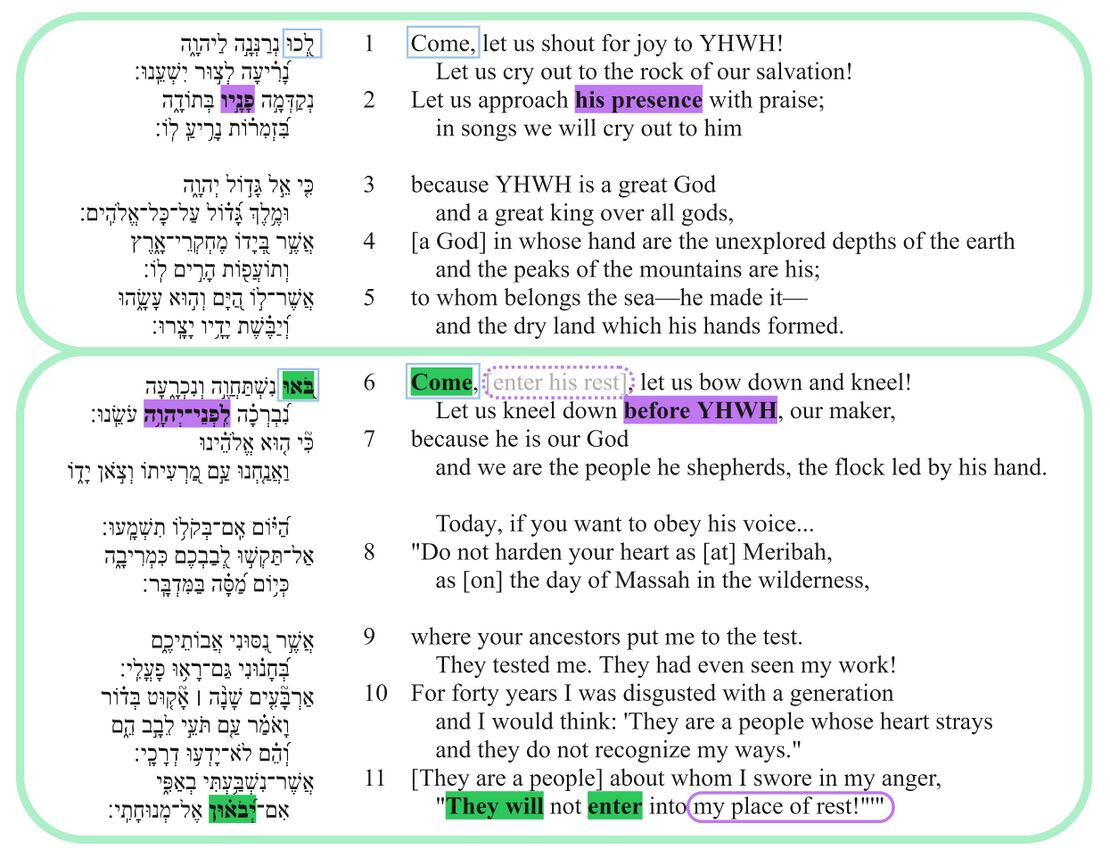Psalm 95 Poetic Features
Poetic Features
In poetic features, we identify and describe the “Top 3 Poetic Features” for each Psalm. Poetic features might include intricate patterns (e.g., chiasms), long range correspondences across the psalm, evocative uses of imagery, sound-plays, allusions to other parts of the Bible, and various other features or combinations of features. For each poetic feature, we describe both the formal aspects of the feature and the poetic effect of the feature. We assume that there is no one-to-one correspondence between a feature’s formal aspects and its effect, and that similar forms might have very different effects depending on their contexts. The effect of a poetic feature is best determined (subjectively) by a thoughtful examination of the feature against the background of the psalm’s overall message and purpose.
The Rock of Refreshment
If an emendation or revocalization is preferred, that emendation or revocalization will be marked in the Hebrew text of all the visuals.
| Emendations/Revocalizations legend | |
|---|---|
| *Emended text* | Emended text, text in which the consonants differ from the consonants of the Masoretic text, is indicated by blue asterisks on either side of the emendation. |
| *Revocalized text* | Revocalized text, text in which only the vowels differ from the vowels of the Masoretic text, is indicated by purple asterisks on either side of the revocalization. |
Feature
In Ps 95:1, YHWH is introduced as "the rock of our salvation."
The final section of the psalm (vv. 7c-11) warns the people of irreverent worship today based on the ancestors' failures in putting YHWH to the test in the past, at the waters of Meribah/Massah (see v. 8). There, immediately following the Exodus, the people grumbled against Moses in the wilderness as they asked for water, and "tested the Lord saying, 'Is the Lord among us or not?'" (Exod 17:7, NIV). That entire episode was characterized by the rock: "I will stand there before you by the rock (הַצּוּר֮) at Horeb. Strike the rock (בַצּ֗וּר), and water will come out of it for the people to drink" (Exod 17:6, NIV).
Effect
Although "rock" (צוּר) is a common title for YHWH throughout the Bible, including the Psalms, it takes on a special significance and irony in Ps 95—a psalm rhetorically dominated by the event of Meribah/Massah, where Moses struck the rock (צוּר).
The opening reference to YHWH as "the rock of our salvation" (v. 1) anticipates the reference to the ancestors' failure to trust God in Meribah/Massah, a crucial part of the reverent decree of warning which dominates the second half of the psalm. Referring to YHWH "the rock of our salvation," however, highlights the irony in that, though their ancestors questioned "Is the Lord among us or not?" (Exod 17:7), the Lord does not reject their descendants, but invites them to trust him and enter the rest of his presence (v. 11b). While the ancestors tested YHWH (v. 9; cf. Exod 17:7), YHWH now tests the present generation. Will they respond to the psalm's message by longing for the rest provided by their Rock (see poetic feature #3), or continue to pursue a false rock in the idolatrous pursuit of comfort (1 Cor 10:5-7)?
Breaking with the Past
If an emendation or revocalization is preferred, that emendation or revocalization will be marked in the Hebrew text of all the visuals.
| Emendations/Revocalizations legend | |
|---|---|
| *Emended text* | Emended text, text in which the consonants differ from the consonants of the Masoretic text, is indicated by blue asterisks on either side of the emendation. |
| *Revocalized text* | Revocalized text, text in which only the vowels differ from the vowels of the Masoretic text, is indicated by purple asterisks on either side of the revocalization. |
Feature
There are only two temporal adverbials ("today" in v. 7c and "for forty years" in v. 10a) in Psalm 95. They appear in syntactically ambiguous positions, being plausibly interpreted with the preceding or following clause.
Ps 95:7c, "today":
# Modifying what's before:
- "For He is our God, and we are the people of his pasture and the sheep of his hand today, if you will obey his voice and not harden their hearts."[1]
# Modifying what's after:
- Today, if you want to obey his voice...
- "Do not harden your hearts as..."
As noted by one scholar, "this section of the verse joins the two parts of the Psalm and ... it should be seen as simultaneously concluding v. 7 and introducing v. 8."[2] Our preferred reading of the syntax is option 2, which you can read about in detail here: The Syntax of Psalm95:7-8.
Ps 95:10, "for forty years":
# Modifying what's before:
- "They had even seen my work for forty years! I was disgusted..."
- This interpretation is shared by Hebrews 3:9-10 (see the grammar notes) and is reflected in the Peshitta's verse division (ܚܙܘ ܥܒ̈ܕܝ ܐܪ̈ܒܥܝܢ ܫܢܝ̈ܢ "they saw my works forty years")—cf. de-Rossi, Variae Lectiones, vol. 4, 64—and the punctuation provided by the editors of the Leiden critical edition of the Peshitta.[3]
# Modifying what's after:
- "They had even seen my work! For forty years I was disgusted..."
Of course, it is true that the people both saw YHWH's works for forty years (Acts 7:36), and YHWH was disgusted with them for this length of time. Nevertheless, the second interpretation of the syntax is strongly preferable in view of the MT and other ancient versions.
Effect
This "Janus" position of the temporal adverbials iconically sets out the choice to “align with what went before” or to “align with what comes after,” as in following the ways of the ancestors or choosing a different path for the future. Nevertheless, in both cases the syntax is preferably read as continuing into the following clause, breaking with the past and projecting a new, better future of covenantal faithfulness to YHWH.
YHWH's Presence is Rest
If an emendation or revocalization is preferred, that emendation or revocalization will be marked in the Hebrew text of all the visuals.
| Emendations/Revocalizations legend | |
|---|---|
| *Emended text* | Emended text, text in which the consonants differ from the consonants of the Masoretic text, is indicated by blue asterisks on either side of the emendation. |
| *Revocalized text* | Revocalized text, text in which only the vowels differ from the vowels of the Masoretic text, is indicated by purple asterisks on either side of the revocalization. |
Feature
Ps 95 begins both halves of the psalm with a plural imperative as an invitation to worship and exhortation to submission, respectively.
The second half of the psalm contains an inclusio with the verb בוא. The place entered in v. 6 is the temple, as the psalm's audience is exhorted to enter, and the promised land in v. 11b, where the ancestors failed to enter.
Effect
The poetic structure formed around the invitation to "come" (לְ֭כוּ and בֹּ֭אוּ, both boxed in blue)—and especially the verbal root בוא—contrasts the rest promised to those reverently worshiping in YHWH's presence with praise (v. 2a, 6b; cf. Ps 100:4) and the resting place promised to, but not attained by, the ancestors (v. 11b).
The poetic implication is that the "place" of worship, YHWH's "rest," has now become YHWH's presence. The ancestors did not enter into the place of YHWH's rest ... will the present generation?
Repeated Roots
The repeated roots table is intended to identify the roots which are repeated in the psalm.
| Repeated Roots legend | |
|---|---|
| Divine name | The divine name is indicated by bold purple text. |
| Roots bounding a section | Roots bounding a section, appearing in the first and last verse of a section, are indicated by bold red text. |
| Roots occurring primarily in the first section are indicated in a yellow box. | |
| Roots occurring primarily in the third section are indicated in a blue box. | |
| Roots connected across sections are indicated by a vertical gray line connecting the roots. | |
| Section boundaries are indicated by a horizontal black line across the chart. | |
Notes
- The name יהוה is limited almost to the first half of the psalm, appearing for the third and final time in the first verse of the second half.
- The root פנה (circled in black) also appears towards the beginning of both halves of the psalm.
- There is an almost symmetrical cluster of אֱלֹהִים, יָד and עשׂה (circled in purple) in the center of the psalm (vv. 3-7), which reflects the involvement of his "hands" in creation and also as a shepherd, such that the psalmist can refer to him as אֱלֹהֵנוּ "our God."
- Finally, the the root בוא (circled in pink) forms an inclusio around vv.6–11. Other repetitions in this section include עַם ,יוֹם ,לֵבָב (circled in green) and נסה. These are repeated in a near-symmetric pattern.








